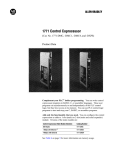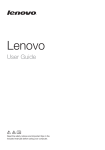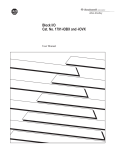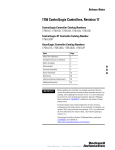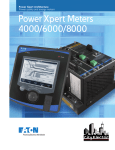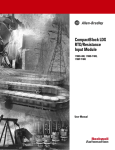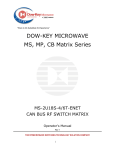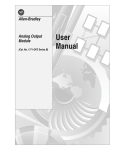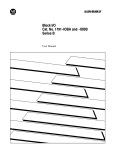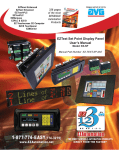Download 1785-2.36, 1785 Enhanced PLC-5 Processors, System Overview
Transcript
1785 Enhanced PLC5 Processors (Cat. Nos. 1785-L11B, -L20B, -L30B, -L40B, -L40L, -L60B, -L60L, -L80B System Overview Table of Contents PLC5 Processors . . . . . . . . . . . . . . . . . . . . . . . . . . . . . . . 2 Multiple Programming Language Support . . . . . . . . . . . . . 2 relay ladder logic . . . . . . . . . . . . . . . . . . . . . . . . . . . . . . . . . . . . structured text . . . . . . . . . . . . . . . . . . . . . . . . . . . . . . . . . . . . . . sequential function charts . . . . . . . . . . . . . . . . . . . . . . . . . . . . . . 3 5 5 Powerful Program Control Features main control programs 6 processor interrupt routines . . . . . . . . . . . . . . . . . . . . . . . . . . . . 6 PID algorithms . . . . . . . . . . . . . . . . . . . . . . . . . . . . . . . . . . 6 Password and Privilege System Protection . . . . . . . . . . . . 7 Advanced Math Functions . . . . . . . . . . . . . . . . . . . . . . . . . 7 Coprocessing Options . . . . . . . . . . . . . . . . . . . . . . . . . . . . 7 Builtin Serial Port . . . . . . . . . . . . . . . . . . . . . . . . . . . . . . . 8 Configurable Communication Port . . . . . . . . . . . . . . . . . . . . . . . . Ethernet Processors . . . . . . . . . . . . . . . . . . . . . . . . . . . . . . . . . . PLC5 Ethernet Interface Module . . . . . . . . . . . . . . . . . . . . . . . . . 8 9 9 Extendedlocal Processors . . . . . . . . . . . . . . . . . . . . . . . . 10 VME Processors . . . . . . . . . . . . . . . . . . . . . . . . . . . . . . . . 10 Selecting a Processor . . . . . . . . . . . . . . . . . . . . . . . . . . . . 11 Input/Output Selections . . . . . . . . . . . . . . . . . . . . . . . . . . . . . . . . Selecting I/O . . . . . . . . . . . . . . . . . . . . . . . . . . . . . . . . . . . . . . . Selecting a Chassis . . . . . . . . . . . . . . . . . . . . . . . . . . . . . . . . . . Selecting a Power Supply . . . . . . . . . . . . . . . . . . . . . . . . . . . . . . Processor Options . . . . . . . . . . . . . . . . . . . . . . . . . . . . . . . . . . . 12 15 19 20 21 EEPROM Module Memory . . . . . . . . . . . . . . . . . . . . . . . . . 21 ii Table of Contents Expand System Fault Tolerance . . . . . . . . . . . . . . . . . . . . . 21 Coprocessor Programming Flexibility . . . . . . . . . . . . . . . . . . . . . . Integrating the System . . . . . . . . . . . . . . . . . . . . . . . . . . . . . . . . 21 22 RSView Man/Machine Interface Software . . . . . . . . . . . . . . 22 Open Architecture . . . . . . . . . . . . . . . . . . . . . . . . . . . . . . . . . . . SCADA Systems . . . . . . . . . . . . . . . . . . . . . . . . . . . . . . . . . . . . Ethernet Network . . . . . . . . . . . . . . . . . . . . . . . . . . . . . . . . . . . . ControlNet . . . . . . . . . . . . . . . . . . . . . . . . . . . . . . . . . . . . . . . . . DeviceNet . . . . . . . . . . . . . . . . . . . . . . . . . . . . . . . . . . . . . . . . . Using the Software . . . . . . . . . . . . . . . . . . . . . . . . . . . . . . . . . . . A.I. Series Features . . . . . . . . . . . . . . . . . . . . . . . . . . . . . . . . . . AllenBradley Support . . . . . . . . . . . . . . . . . . . . . . . . . . . . . . . . For More Information ... . . . . . . . . . . . . . . . . . . . . . . . . . . . . . . . What to Do Next . . . . . . . . . . . . . . . . . . . . . . . . . . . . . . . . . . . . Preparing to Layout a PLC5 System . . . . . . . . . . . . . . . . . . . . . . 24 24 25 26 27 28 28 29 30 31 32 1785 Enhanced PLC5 Processors System Overview Introducing PLC5 Processors Introducing the PLC5 System PLC-5 with 1785-ENET Module Remote I/O Remote 1771–I/O Chassis 1791-IOBX 128-point Block Flex I/O 1791-16AC 32-I/O Block PanelView Operator Interface 1336 PLUS Drive 1400-PD Power Monitor Display Module Flex I/O 1747-ASB 1794-CE1 1ft. extender cable Flex I/O 20063–M PLC5 processors are highspeed, singleslot processors you can use for control and information processing. These processors offer advanced programming features and versatile communication options to fit your unique application. This book introduces Enhanced PLC5 processors which include PLC5/11, 5/20, 5/30, 5/40, 5/40L, 5/60, 5/60L, and 5/80 processors. We use the term PLC5 processors to signify Enhanced PLC5 processors. For more information... 0 Keep in mind that PLC5 processors are designed for larger sequential and regulatory control applications with specialized I/O requirements and/or the need to coordinate with other processors and devices. If your application is a simple analog or discrete one, requiring a smaller amount of I/O or memory, you may want to consider a SLC processor. For more information about SLC processors, see the SLC System Overview, publication 17472.30. 1785 Enhanced PLC5 Processors System Overview Introducing PLC5 Processors Using this Book Use this book to approximate your needs and to begin to lay out a PLC-5 system that fits your particular application. With the help of this book, you’ll see how easy it is to configure and use a PLC-5 system. For information about: processor features and capabilities selecting a processor input/output selections selecting I/O selecting a chassis selecting a power supply processor options integrating a system open architecture support programming software support services preparing to layout a system See page: 2 11 12 15 19 20 21 22 24 28 29 32 At the back of this book, we include guidelines to help you consider each option and to begin to lay out a system. Follow these guidelines as you move through each section of this book. If you need more information, please call your Allen-Bradley representative. 1 1785 Enhanced PLC5 Processors System Overview Introducing PLC5 Processors PLC5 Processors All PLC5 processors share the following common features: Multiple Programming Language Support structured text, sequential function charts, ladder logic, function block Powerful Program Control Features 16 main control programs, time and eventdriven processor interrupt routines, PID algorithms Advanced Instruction Set includes basic and advanced ASCII string instructions, and advanced math functions Builtin Communications RS232/422/423, Data Highway Plus, Remote I/O Control Network, remote I/O communication distances up to 10,000 feet or 3,048 meters System Protection passwords and privileges communication backup module Program Execution Speed 0.5ms/k bit instructions, 2ms/k typical mix The next few pages describe these features. See page 11 to select a processor. Environmental Conditions: operating temperature: 0 to 60° C (32140° F) storage temperature: 40 to 85° C (40 to 185° F) relative humidity: 595% (without condensation) Time of Day Clock and Calendar (battery backed): maximum variations at 60° C: +/ 5 min per month typical variations at 20° C: +/ 20s per month timing accuracy: one program scan Note: calendar updates appropriately each year, including the year 2000 Agency Certification: CSA certified, CSA Class I, Division 2, Groups A, B, C, D, UL listed CE marked for all applicable directives (when product or packaging is marked) Shock: Operating: 30 g peak acceleration for 11±1 ms duration Nonoperating: 50 g peak acceleration for 11±1 ms duration Vibration Testing (operating and nonoperating): 1 g @ 10 to 500 Hz 0.012 inches peaktopeak displacement Location: 1771I/O chassis, leftmost slot Multiple Programming Language Support 2 PLC5 processor Communication: Data Highway Plust (trunk line: 3048 cablem (10,000 cableft); drop line: 30.4 cablem (100 cableft) Data Highway (DH) using 1785KA Serial Ethernet (TCP/IP protocol, 15pin AUI transceiver port) remote I/O extendedlocal I/O (PLC5/40L and 5/60L processors only) Backplane Current: 2.3A (PLC5/11t, 5/20t, 5/30t) 3.3A (PLC5/40t, 5/40Lt, 5/60t, 5/60Lt, 5/80t, 5/86t) 3.6A (PLC5/20Et, 5/40Et, 5/80Et) Processor Weights: PLC5/20, 5/26: 1.21 kg (2.7 lbs) PLC5/30: 1.20 kg (2.6 lbs) PLC5/40, 5/46, 5/40L: 1.42 kg (3.1 lbs) PLC5/60, 5/60L: 1.42 kg (3.1 lbs) PLC5/80, 5/86: 1.42 kg (3.1 lbs) PLC-5 processors support multiple industry-standard programming languages; you can program logic in IEC 1131-based structured text, function block, sequential function charts, or ladder logic. This versatility means you can maintain and troubleshoot programs in the same language that you develop them in. 1785 Enhanced PLC5 Processors System Overview Introducing PLC5 Processors relay ladder logic All PLC-5 processors support the following built-in instructions: Relay Sequence 1, 2 ... 6 Shift Register bit →← Compute Conversion x'y Examine On (XIC) Examine Off (XIO) Energize (OTE) Latch (OTL) Unlatch (OTU) Sequencer Input (SQI) Sequencer Output (SQO) Sequencer Load (SQL) Smart Directed Sequencer (SDS) Diagnostic Fault Annuciator (DFA) Bit Shift Left (BSL) Bit Shift Right (BSR) Compute (CPT) Multiply (MUL) Negate (NEG) Sine (SIN) Square Root (SQR) Sort File (SRT) Subtract (SUB) Tangent (TAN) Arc Sine (ASN) Arc Cosine (ACS) Convert to BCD (TOD) Convert from BCD (FRD) Degree (DEG) Radian (RAD) Timer/Counter Timer On Delay (TON) Timer Off Delay (TOF) Retentive Timer On (RTO) Count Up (CTU) Count Down (CTD) Timer and Counter Reset (RES) File File Arithmetic and Logic (FAL) File Search and Compare (FSC) File Copy (COP) File Fill (FLL) Logical Log to the Base 10 (LOG) Natural Log (LN) Divide (DIV) Cosine (COS) Clear (CLR) Average File (AVE) Arc Tangent (ATN) Addition (ADD) Standard Deviation (STD) X to the Power of Y (XPY) FIFO Load (FFL) FIFO Unload (FFU) LIFO Load (LFL) LIFO Unload (LFU) AND NOT OR Exclusive Or (XOR) 3 1785 Enhanced PLC5 Processors System Overview Introducing PLC5 Processors Compare Move Compare (CMP) Equal To (EQU) Greater than or Equal to (GEQ) Greater than (GRT) Less than or Equal to (LEQ) BIt Distribute (BTD) Move (MOV) Masked Move (MVM) I/O Message Block Transfer Write (BTW) Block Transfer Read (BTR) Message (MSG) Program Control Jump (JMP) Label (LBL) Break (BRK) Subroutine (SBR) Return (RET) Master Control Reset (MCR) User Interrupt Disable (UID) ASCII PID Diagnostic Specialty Special Less than (LES) Limit Test (LIM) Mask Compare Equal to (MEQ) Not Equal to (NEQ) User Interrupt Enable (UIE) For Next Loop (FOR, NXT) Jump to Subroutine (JSR) End of Transition (EOT) Temporary End (TND) Always False (AFI) Sequential Function Chart Reset (SFR)) Test Buffer for Line (ABL) ASCII Write (AWT) ASCII String to Integer (ACI) ASCII String Search (ASC) ASCII String Extract (AEX) ASCII Integer to String (AIC) ASCII Set or Reset ASCII Write with Append (AWA) Handshake Lines (AHL) ASCII String Comapre (ASR) ASCII String Concatenate (ACN) ASCII Read Line (ARL) Number of Characters in Buffer (ACB) ASCII ReadCharacters (ARD) Proportional, Integral, Derivative (PID) File Bit Comparison (FBC) Diagnostic Detest (DDT) Data Transitional (DTR) One Shot (ONS) One Shot Rising (OSR) Immediate Output (IOT) One Shot Falling (OSF) Immediate Input (IIN) This broad range of instructions can save you time in developing programs by providing the instructions you need ready-made for your application. 4 1785 Enhanced PLC5 Processors System Overview Introducing PLC5 Processors structured text Programming Example IF (T4:0.DN) THEN TON (T4:0,0.01, 100, 0); ELSE RES (T4:0); END_IF; IF (!(T4:0.DN) THEN TON (T4:0, 0.01,100, 0); ELSEIF (T4:0.DN) THEN RES (T4:0); END_IF; Structured text resembles BASIC programming and you can use it to easily create, edit, and execute complex algorithms that involve variables representing a wide range of data types. Structured text works well in the following types of applications: data handling decision making ■ ■ ■ ■ computational sorting intensive mathematical With Allen-Bradley’s structured text option, you can use the PowerTexttmonitoring tool to integrate real-time data table values with a structured text source program. See the example on the left. Structured text supports the following constructs for PLC-5 processors: Variable Assignment Nonretentive Bit Assignment Make binary assignments to a storage bit. These bits are cleared to 0 when the processor mode changes from Program to Run or when the SFC step is postscanned. Make binary assignments to a storage bit. These bits are not cleared to 0 when the processor mode changes from Program to Run or when the SFC step is postscanned. IFELSIFELSE Conditionally execute a section of code. FOR Repeat a section of code a specified number of times. WHILE Repeat a section of code as long as an input expression is true. REPEAT Repeat a section of code until an expression becomes true. EXIT Exit an iterative construct (REPEAT, FOR, or WHILE) before the processor reaches the normal termination condition. CASE Conditionally execute a section of code based on the value of a math expression or operand. Provided for IEC 11313 compatibility, similar to an NOP statement. ;; Call as a function almost any ladder instruction. You can use sequential function charts (SFCs) to control and display the state of a control process. Instead of one long ladder or structured text program for your application, divide the logic into manageable steps and transitions. Mixer 1 In this simple SFC, the logic for the mixer step is executed repeatedly until its transition is true. Then the processor executes the dump logic repeatedly until its transition is true. := Retentive Bit Assignment RETAIN Ladder Functions sequential function charts Assign an integer or a floating point value to a data table location. := 7 9 Dump 1 A step corresponds to a control task; a transition corresponds to a condition that must occur before the processor can perform the next control task. By displaying these steps and transitions, you can see the state of a machine process at any time. 8 10 5 1785 Enhanced PLC5 Processors System Overview Introducing PLC5 Processors Powerful Program Control Features main control programs You can use any mix of SFC, ladder, and structured text programs to define up to 16 main control programs (MCPs). Use several MCPs to define one main control program for each particular machine or function of your process. For example, you can specify an SFC program to define the order of events in a process and a separate ladder logic or structured text program to directly control the outputs. Each of these can be an MCP. This lets you independently execute SFCs, ladder logic and structured text to structure your application into functional units and ease troubleshooting. processor interrupt routines You can specify both time- and event-driven interrupt routines for PLC-5 processors. Use selectable timed interrupts (STIs) when you want a portion of logic to execute at a specified time interval. For example, you can use an STI to monitor a machine’s position every 250ms and calculate the average rate-of-change. Use processor input interrupts (PIIs) when you want to execute a portion of logic immediately when an event occurs. For example, you can use a PII to eject a faulty bottle from a bottling line. A PII can detect an event within 100 microseconds and can act on successive events within 3 milliseconds. PID algorithms You can use Proportional Integral Derivative (PID) closed-loop control to hold a process at the set point you want. The PID instruction lets your processor monitor and control process loops for quantities such as pressure, temperature, flow rate, and fluid level. PID algorithms feature the following: features equations expressed in ISA or Independent Gains output alarms output limiting with antireset windup input and output transfer from 04095 (12bit analog) manual mode (with bumpless transfer) input scaling in engineering units feedforward or output biasing zerocrossing deadband displaying and monitoring PID values derivative term (can act on PV or error) direct or reverse acting control 6 1785 Enhanced PLC5 Processors System Overview Introducing PLC5 Processors You can protect your programs using the processor’s built-in passwords and privileges feature. Set up to four privilege classes, each with access to different software operations. You can use passwords and privileges to protect: overall privilege classes channels stations/nodes individual programs and data files generate a report to list the privileges you have assigned Advanced Math Functions Coprocessing Options Data Highway Plus Password and Privilege System Protection maintenance terminal read only access for file 1 privilege class 2 system administrator read/write access privilege class 1 You can use a floating point data table file and the advanced math functions to perform complex calculations. Advanced math functions include logarithmic, trigonometric, statistical, exponential and square root functions. PLC-5 processors offer a built-in side connection that lets you connect directly to a control coprocessor module or Ethernet module. This connection also lets you access an Ethernet network with the processor. See page 21 for more detailed information about coprocessor modules. See page 9 for more information about Ethernet options. 7 1785 Enhanced PLC5 Processors System Overview Introducing PLC5 Processors Builtin Serial Port The serial port lets you interface with various modems to support Supervisory Control and Data Acquisition (SCADA) applications. For more information about SCADA applications, see page 24 or see the SCADA System Application Guide, publication AG6.5.8. For more information... PLC-5 processors offer a built-in serial port that you can configure for RS-232C, RS-423, or RS-422A communication. This serial port works directly with Allen-Bradley serial equipment so you don’t need to buy anything extra. You can use the processor’s serial port to connect the processor to other Allen-Bradley and non-Allen-Bradley devices that: can send and receive ASCII characters communicate using DF1 protocol The processor’s serial port supports these configurations: Keep in mind that when you configure channel 0 for RS422A compatibility, you should not use terminating resistors anywhere on the link. When you configure channel 0 for RS422A compatibility and RS423, do not go beyond 200 feet regardless of baud rate. Configurable Communication Port For more information... RSPort: Maximum Cable Length: 232C 422A 423 15 m (50 ft) 61 m (200 ft) 61 m (200 ft) PLC-5 processors offer built-in, configurable Data Highway Plus (DH+) or Remote I/O (RIO) ports. DH+ supports data transfer and remote programming for factory-floor applications in addition to peer-to-peer communications between other processors and devices. Remote I/O supports real-time data exchange for control of plant-floor devices. With 6200 PLC-5 programming software, you can program PLC-5 processors over your DH+ network. This means that you can connect a single industrial terminal to your network and use it to program all the PLC processors on your network. You can also use DH+ modules to implement a SCADA network. For more information about SCADA applications, see page 24 or see the SCADA System Application Guide, publication AG-6.5.8. The remote I/O network connects chassis-based I/O and other compatible intelligent RIO devices to PLC-5 processors. Allen-Bradley designs its devices to be compatible with this link. Other vendors offer products that are also compatible with remote I/O network links. These products include robotic and welding controllers, scales, and wireless modems. You can use the RIO link to speed communications and let the devices work together to improve quality while lowering integration, maintenance, and training costs. I/O chassis and other devices on the link can be mounted up to 10,000 feet or 3,048 meters away from PLC processors. Or, for distributed processing, you can put a processor right at the I/O chassis where it can monitor its own resident I/O while communicating with a supervisory controller over the remote I/O link. 8 1785 Enhanced PLC5 Processors System Overview Introducing PLC5 Processors Ethernet Processors Dedicated Ethernet Port Ethernet PLC-5/20E, -5/40E, and -5/80E processors offer embedded Ethernet TCP/IP communication capabilities; these processors provide the integration of Allen-Bradley architecture into an industry-standard Ethernet TCP/IP system, offering flexible, open-system solutions. With the Ethernet processors’ built-in communication capabilities, you have access to the entire Allen-Bradley control, communication, and information architecture. The Ethernet processors are optimized for real-time sequential and regulatory control and offer extensive application flexibility. See page 25 for more information about Ethernet solutions. PLC5/20E PLC5/40E and processor 5/80E processor PLC5 Ethernet Interface Module Enhanced PLC5/40 The PLC-5 Ethernet Interface Module is a single-slot module that attaches to the side of any Enhanced PLC-5 Series B or later processor to provide Ethernet connectivity for the attached processor. When used with The interface module provides Enhanced PLC5 processor Ethernet connectivity without sacrificing DH+/RIO ports ControlNet PLC5 processor Ethernet connectivity Ethernet PLC5 processor the ability to operate dual Ethernet links 1785ENET interface module 9 1785 Enhanced PLC5 Processors System Overview Introducing PLC5 Processors Extendedlocal Processors Extendedlocal Port For more information... With PLC-5/40L and -5/60L processors and an extended-local I/O adapter module, you can use an extended-local I/O link to speed I/O updates. The extended-local I/O link is a parallel link that enables a PLC-5/40L or -5/60L processor to scan a maximum of 16 extended-local I/O chassis. Extended-local I/O chassis are updated in less than .5 milliseconds and can be connected up to 100 feet away from the chassis. For more information about PLC-5/40L and -5/60L processors, see the Enhanced PLC-5 Programmable Controllers User Manual, publication 1785-6.5.12. PLC5/40L and 5/60L processor VME Processors With PLC-5/VME VMEbus programmable controllers (PLC-5/VME processors), you can bring the technology of PLC-5 processors to the VMEbus environment. PLC-5/VME processors are functionally equivalent to other PLC-5 processors, but also: plug into a VMEbus system have a VMEbus communication interface designed for use with other VMEbus CPU modules can access VMEbus I/O modules PLC5/V30B PLC5/V40B PLC5/V40L processor processor processor For more information... 10 For more information about PLC-5/VME processors, see the PLC-5/VME User Manual, publication 1785-6.5.9. System Overview Introducing PLC5 Processors Selecting a Processor All PLC5 processors share the common features described in the previous section, and some offer special communication options. Choose the right PLC5 processor for your application by selecting the processor that meets the I/O, memory, and communication requirements to control your process. See the table below. I/O Count: Memory: Communication ports: Processor: 256 (any mix) 8K 1 DH+/Remote I/O PLC5/11 512 (any mix) 1024 (input +output) 16K 1 DH+, 1 DH+/Remote I/O PLC5/20 1 DH+, 1 DH+/Remote I/O, 1 Ethernet PLC5/20E 1024 (any mix) 1024 (input +output) 2048 (any ( y mix)) 2048 (input +output) 32K 2 DH+/Remote I/O PLC5/30 48K 4 DH+/Remote I/O 3072 (any mix) 3072 (input +output) 64K 2 DH+/Remote I/O, 1 Local I/O 2 DH+/Remote I/O, 1 Ethernet 4 DH+/Remote I/O PLC5/40 PLC5/40L 3072 (any mix) 3072 (input +output) 100K PLC5/40E PLC560 2 DH+/Remote I/O, 1 Local I/O PLC5/60L 4 DH+/Remote I/O PLC5/80 2 DH+/Remote I/O, 1 Ethernet PLC5/80E example REQUIREMENTS: You have 2,000 I/O points and need 50K of memory. You also want Ethernet access. Use the selection chart above to find which processors support your I/O count. In this case, the PLC5/40, 5/40L, 5/40E, 5/60, 5/60L, 5/80, and 5/80E processors all support your I/O count. Use the chart to find which of those processors support your memory requirements. In this case, only the PLC5/60, 5/60L, 5/80, and 5/80E support both your I/O count and your memory requirement. Use the chart to find which of those processors support your communication requirements. In this case, you would select the PLC5/80E, because only the PLC5/80E supports Ethernet access, along with your I/O and memory requirements. 11 1785 Enhanced PLC5 Processors System Overview Input/Output Selections Input/Output Selections Allen-Bradley offers over 90 types of I/O modules and has 3 million modules installed in applications worldwide. 1771 series I/O is the industry’s largest selection of I/O modules and addresses a broad range of manufacturing and process control applications. We offer both rack- and block-based I/O selections. PLC5/40 Remote I/O PanelView Operator Interface Remote Rack 1771ASB 1791IOBX 128point Block 1336 Drive Flex I/O 179116AC 32point Block 1400PD Power Monitor Display Module Flex I/O 1747ASB AB The following sections outline the available I/O selections. For more information about any of these selections, contact your Allen-Bradley representative. The following types of documents may assist you: ■ ■ ■ 12 product bulletins product datas user manuals ■ product catalogs selection guides ■ simplified schematics ■ ■ ■ ■ reference guides installation datas application notes 20063 1785 Enhanced PLC5 Processors System Overview Input/Output Selections 1771 series I/O offers over 90 modules to handle your discrete, analog, or special requirements. 1771 modules feature: ■ ■ ■ 1794 series I/O (Flex I/O) is a flexible, lowcost, modular I/O system for distributed applications. Because flex I/O combines a terminal strip with an I/O interface, you can use the terminal strip on the terminal base to wire your field devices directly. Direct wiring saves you: installation and testing time additional wiring and external terminal blocks control panel space Combining your field wiring terminations and the I/O interface into the same location saves you time and money and makes your system easier to maintain and troubleshoot. a broad range of signal interfaces to ac and dc sensors/actuators to fit your application modules available in different densities for up to 32 I/O for greater flexibility and cost savings wide range of signal levels including standard analog inputs and outputs and direct thermocouple and RTD temperature inputs 1794 modules feature: ■ ■ ■ ■ ■ modularity of design: reduces costs by solving a large range of application requirements with one I/O architecture small size: reduces packaging costs individual wire termination locations: reduces purchasing costs and complexity, as well as packaging costs diagnostics and removal and insertion under power capability: lowers the mean time to repair equipment and leverages your control investment flexible communications: helps to control future costs by providing an economical migration path 13 1785 Enhanced PLC5 Processors System Overview Input/Output Selections 1746 series I/O is modular in its hardware design and offers a cost and spaceeffective means to add I/O modules to your control system. I/O modules are available in 4, 8, 16, and 32point densities so that you can place many I/O modules in a single location. 1746 modules feature: ■ ■ ■ highdensity 32point and combination modules: reduces rack size and panel space requirements removable terminal blocks on 16point modules: you can easily wire and replace modules industrial design: input filtering and optical isolation for exceptional reliability in industrial applications 1791 series block I/O puts its power in one small package so you can distribute your I/O more efficiently and install your system more cheaply than with comparable chassisbased I/O. 1791 modules feature: ■ ■ ■ 14 a selfcontained package that provides costeffective distribution of as few as 16 discrete I/O points to a remote location small size that lets you install blocks in a protected area of a machine or process you can panel or DINrail mount most 16 and 32point ac, dc, and analog blocks in a vertical or horizontal operation 1785 Enhanced PLC5 Processors System Overview Selecting I/O Selecting I/O Select I/O to match the electrical requirements of your field devices. The following charts highlight the available modules. 1771 Standard Analog I/O Modules (12bit resolution) Channel Update/Resolution 25ms/8 channels 15 bits+sign (0.1°C/0.1° F/bit) Voltage Range Type B, E, J, K, R, S, T ±99.99mV Current Range N/A Data Format Binary only 6 RTD inputs (three wire) 50ms/8 channels 16 bit resolution (0.1°C/0.1° F/bit) 100W platinum 10W copper or other N/A Binary or BCD Actual temperature or Ohm readings 4 isolated outputs (1000 V) 8.0ms/4 chnls (BCD) 1.6ms/4 chnls (Binary) 12bit res + sign 15V dc 010V dc ±10V dc 420 mA 050 mA Binary or BCD Scaled to ±9999 Type HighRes TC/mV Input Number of Inputs/Outputs 8 floating differential RTD Input Analog Output 1771 High Resolution Analog I/O Modules (16bit resolution) Input Type Number of Inputs Output Types Type Number of Outputs Current 420mA 0, 2, 4, 6, 8 Current 025mA, 050mA 0, 2, 8 MV/TC B, R, S,E, J, K, T Voltage "10V dc RTD Platinum, Nickel, Copper Voltage "10V dc, "5Vdc BuildtoOrder Program: We will quote you a custom configuration when you tell us your type and number of input and output requirements. Contact your AllenBradley representative for details. 1771 Discrete Output Modules Number of Modules Type Voltage Category Number of Outputs Current Per Output 2 ac 24 8,, 16 1.5A,, 2.0A Applications ■ ■ 7 120 4, 6, 8, 16 ■ ■ ■ ■ 3 1 2 6 dc 220 120/220 5 TTL 66, 8, 8 16 32 8, 16 10-60 8, 16, 32 22.0A 0A 0.3A 0.2A sinking 0.001A sourcing .5A, 1A, 1.5A, 2A ■ ■ ■ ■ ■ 2 10-32 16-32 0.5A, 2A ■ ■ ■ Relay coil driver Low voltage inductive loads Protected ac output Isolated circuits Individually fused General purpose General purpose p p TTL interfaces V dc output signal termination Isolated circuits electronic fusing/current limiting isolated circuits general purpose +V dc output signal termination 15 1785 Enhanced PLC5 Processors System Overview Selecting I/O 1771 Process Control I/O Modules Module Number of Inputs/ Outputs PID Control Module 2 PV inputs 2 tieback inputs 2 outputs External Power Required Channel Update/ Resolution Voltage Range Current Range Data Format ±15V dc 100ms (Loop) 12 bit resolution 15V dc 420 mA Scaled BCD ±9999 1771 Discrete Output Relay Modules Number of Modules 4 Operating Voltage 24138 V ac 24125 Vdc (30 watts max) Number of Outputs 8, 16, 32 Current Per Output 0.25A-2A 1 0250 ac 0175 dc 4 isolated 2A @ 200V ac 4 selectable 2 024 ac/dc 8 (4 groups of 2) 0.1A 4 N.O., 4 N.C., 8 N.O. Contacts 8 selectable-32 selectable Applications mixed voltages ■ no leakage current ■ isolated ■ signal switching ■ isolated circuits ■ physical isolation ■ low power dissipation ■ no leakage current ■ 1771 Discrete Input Modules Number of Modules 2 Type Sinking or Sourcing Voltage Current ac/dc / n/a / 24 Number of Inputs 8,, 16 120 6, 8, 6, 8, 16, 16, 32 220 6, 8, 16 5 Applications ■ ■ ■ 3 ac/dc ■ ■ 2 7 2 dc dc TTL sinking sourcing sinking, sourcing 5 10-60 10-30 5-32 8,16 8,16, 32 8, 32 8, 16 ■ ■ Generalpurpose General ppurpose Generalpurpose p Isolatedcircuit multiphase applications Generalpurpose Isolatedcircuit multiphase applications Generalpurpose Generalpurpose p p 1771 Specialty I/O Modules 1771 Communication I/O Modules FiberOptic Converters Local I/O Adapters Remote I/O Adapters I/O Scanners 1771 Specialized Modules Configurable Flowmeter Module Highspeed Logic Controller Latching Input Module Wire Fault Module Multiplexer input Module Clutch/Brake Control System Simulator I/O Module Vision Input Module Power System Line Synchronization Module 16 1771 Positioning Modules Stepper Positioning Modules Servo Positioning Modules with and without Contouring Absolute Encoder Modules Gray Code Encoder Modules Injection Control Modules Force Control Modules Highspeed Control Modules 1771 Peripheral Interface Modules ASCII and BASIC module RS232/422/423 Modules 1785 Enhanced PLC5 Processors System Overview Selecting I/O 1791 Analog I/O Blocks Number of Blocks I/O Block Power Source Inputs Number of Inputs Resolution Ranges Outputs Number of Outputs Resolution Ranges 2 85120V ac 4 14 bits "10V;; "5V 0 10V 005V 010V; 5V 020 mA (block supplies loop power) 2 13,, 14 bits "10V,, 020 mA 19.230V dc 1791 Discrete I/O Blocks Inputs Number of Blocks I/O Block Power Source 9 19.230V dc Outputs Type Number of Inputs 1030V dc sinkingg 0,, 8,16,24, , , , 32 Type Number of Outputs Max Current Per Output (All outputs on unless otherwise noted) 1030V dc sourcing 0,, 8,16, , , 32 500 mA at 60°C-1A at 30°C contact 85120V ac 79132V ac 1826.4V dc 1826.4V dc sourcing 20132V ac 300 mA at 60°C-600 mA at 30°C contact 4 32,, 64 1826.4V dc sinking 1826.4V dc sinking 32,, 64 300 mA at 60°C 1826.4V dc sourcing 1746 Discrete Input Modules Number of Modules Type Voltage Category Number of Inputs Applications 3 AC 85132V 4,, 8,, 16 Generalpurpose 120V ac inputs 170265V 1 Generalpurpose 220/240V ac inputs 5V sourcing 16 TTL input, BCD inputs 3 1030V sourcing 8, 16 Generalpurpose dc inputs; fast response for timecritical applications 1 24V sourcing 32 Generalpurpose dc inputs; highdensity for limited panel space 2 1030V sinking 8, 16 Generalpurpose dc inputs; fast response for timecritical applications 1 24V sinking 32 Generalpurpose dc inputs; highdensity for limited panel space 24V 16 V ac or V dc operation 1 DC AC/DC 1746 Discrete I/O Combination Modules Number of Modules Voltage Types Number of Inputs Output Voltage Types Number of Outputs Applications 3 85132V ac 2,, 4,, 6 5265V ac 2,, 4,, 6 Combination 120V ac inputs p and relayy contact outputs o tp ts 5125V dc relay contact 1746 Discrete Output Modules Number of Modules Types Voltage Category Number of Outputs Current Rating @ 60° C Applications 2 AC 85265V 8,, 16 .25A ,5A Generalpurpose 120/240V ac outputs 4 DC 550V sourcing .5A 1A Generalpurpose dc outputs .25A 1A TTL loads; sourcing BCD devices 5 4 relay contact 550V sinking 832 5265V ac 4, 8, 16 5125V dc individual isolation 4outputs/common 8 t t / 8outputs/common 17 1785 Enhanced PLC5 Processors System Overview Selecting I/O 1746 Analog I/O Modules Type Number of Inputs Input Voltage Range analogg input p 4 ±10V dc Number of Outputs Output Voltage Range 60ms @95% step res. ±20ma analogg output p analogg combination thermocouple/mv p 16 bit resolution 4 ±10V dc 2 4 Channel Update/Resolution 020ma 2.5ms @95% step res. ±10V dc 14 bit resolution 2 60ms @95% step res. ±20ma output 2.5ms 020ma 16 bit resolution J, K, T 12ms @ 100% step res. E, R,S .1° C, .1° F ±50mv 0.01mV ±100mv 1746 Specialty I/O Modules 1746 Communication I/O Modules SLC 500⇒DH485 Interface Direct Communication Module Remote I/O Scanner Remote I/O Adapter 1746 Peripheral Interface Modules 1746 Positioning Modules Basic Module RS232⇒DH485 (DF1 protocol) RS422 RS485 Single Axis Servo Controller Module Highspeed Counter Coder Module 1794 Flex I/O System Components Communication Adapters Terminal Bases Discrete and Analog I/O Modules RIO 2 wire or 3 wire Type Voltage Number of Points DC, sinking, input 24V dc 16 DC, sourcing, output Sensor input AC input 8 120 V ac 8 010 8 AC output Analog input ±10 Analog output 420mA 020mA 18 4 1785 Enhanced PLC5 Processors System Overview Selecting a Chassis and Power Supply Selecting a Chassis If you use 1771 or 1746 I/O modules, you will need to select a chassis when you specify your system. You should consider the following when you select a chassis: When you determine the maximum number of I/O in your application, leave space for the I/O slots dedicated to power-supply modules, communication modules, other intelligent I/O modules, and expansion. 4-Slot I/O chassis are available in four sizes: For 1771 Modules: For 1746 Modules: ■ 4-slot ■ 12-slot ■ 4-slot ■ 10-slot ■ 8-slot ■ 16-slot ■ 7-slot ■ 13-slot For 1771 I/O modules, you can also choose a chassis with an integral power supply and remote I/O adapter. The two types are: ■ ■ 1-slot 2-slot For 1746 I/O modules, you can also choose an optional 2-slot expansion chassis that provides up to 64 additional points of I/O or an interface to specialty I/O modules. 19 1785 Enhanced PLC5 Processors System Overview Selecting a Chassis and Power Supply Selecting a Power Supply You will also need to select a power supply when you specify your system. When you’re ready to select a power supply, these are guidelines you should follow: 1. Determine the input voltage for the power supply. 2. Calculate the total backplane current draw for I/O modules by adding together the backplane current draw for each I/O module in that chassis. 3. Add to the total of the I/O module backplane current draw either: 4. 5. a. 3.3 Amps when the chassis will contain a PLC-5 processor or b. 1.2 Amps when the chassis will contain either a remote I/O 1771-AS or -ASB module or a 1771-ALX extended-local I/O adapter module If you leave slots available in your chassis for future expansion: a. list backplane current draw for future I/O modules b. add the total current draw for all expansion I/O modules to the total calculated in step 3 Determine whether the available space for the power supply is in the chassis or mounted external to the chassis. Choose your power supply using the input voltage requirement and the total backplane current draw you just determined. For 1771 I/O modules, Allen-Bradley offers a wide range of power supplies with input voltages from 120V ac to 220V ac or 240V dc that supply 8 to 24 amps in various configurations. We also supply redundant power supplies for added security. For more information, see your Allen-Bradley representative. AB 20 For 1746 I/O modules, Allen-Bradley offers three different power supplies, two ac and one 24V dc. You can configure the ac supplies to operate using 120 or 240V ac. For more information, see your Allen-Bradley representative. System Overview Processor Options Processor Options EEPROM Module Memory Expand System Fault Tolerance In addition to the base processors, PLC-5 processors offer many options. This section describes these options. You can back up memory by using EEPROM modules that give you alternative storage for your program files. Four sizes are available: 16, 32, 64, and 100K words. You can expand system fault tolerance by using a backup communication module. Backup communication modules provide high-speed communication and switchover to a secondary processor system when a fault or power failure occurs in the primary PLC-5 system. Backup communication modules back up two DH+/RIO ports. Backup expander modules are available to back up an additional two DH+/RIO ports, or four DH+/RIO ports total. Coprocessor Programming Flexibility CPU COMM0 COMM1 With a control coprocessor, you can expand the capability of your PLC-5 system to run programs in C, BASIC, and assembler languages in a real-time, multitasking operating system environment. These programs run independently of PLC-5 control logic but have access to PLC-5 memory. The control coprocessor performs a wide range of functions including: complex math or application-specific algorithms BATTERY alternate control programming with third-party (PSP) programming packages such as fuzzyTech’sR fuzzy logic or Event Technology’s function block programming with GELLOR memory-intensive production scheduling or data logging/trending high-speed search and compare of very large files or look-up tables protocol conversion for interfacing a PLC processor with a variety of field devices The industrially-hardened module fits in a 1771 chassis and offers direct and standard I/O communication with PLC-5 processors. With an optional expander module, you gain two additional serial communication ports, a keyswitch for reinitializing the control coprocessor without cycling power, and a 4-digit alphanumeric display for diagnostic reporting. 21 1785 Enhanced PLC5 Processors System Overview Integrating the System Integrating the System Rockwell Software Inc. (RSI) offers numerous products to ease the integration of your PLC-5 system into new or existing architectures. These products include the following. RSView Man/Machine Interface Software RSView32t leverages open technologies within the Microsoft Windows NTt and Windows 95 platforms such as ODBC, OLE, and DDE. It provides leading edge productivity enhancing tools by allowing changes while online with field equipment. For example, RSView32 allows runtime changes to graphic displays, tag addresses, node addresses, as well as PLC network and device driver configuration adjustments. RSView32's graphics offer the flexibility of integrating ActiveX controls and OLE objects such as Microsoft Excel spreadsheets or Microsoft Word documents along with its own powerful graphical editing tools and libraries. RSView32 takes advantage of the Microsoft Windows NT multitasking environment with its full featured MultiModel Data Logger, Trending, Alarming and Event triggering components to help you define your monitoring and supervisory control needs. personal computer RSView with Windows NT or 95 Ethernet Interface Module PLC5 processor with Ethernet Interface Module DH+ network Ethernet Gateway PLC5/11 processor 22 PLC5/20 processor PLC5/20E processor PLC5/40E or 5/80E processor T70 running RSView software DH+ network PLC5/40 processor PLC5/80 processor SLC 5/04 1785 Enhanced PLC5 Processors System Overview Integrating the System INTERCHANGE Software on an Ethernet Network Ethernet network Ethernet network host application program Host INTERCHANGE Software DH+ network 1785 PLC5 processor RM Ethernet Gateway VAX computer, HP 9000 computer, or IBM RS 6000 PLC5/250 processor PLC3 processor RS PLC5/250 processor DH network PLC2 processor PLC5/20E PLC5/40E or 5/80E processor processor Ethernet Interface (EI) PLC3/10 processor INTERCHANGEt software is an Application Programming Interface (API) that simplifies communication between a variety of host computer operating systems and AllenBradley processors. You can use INTERCHANGE software when you need to share data between plant floor and manufacturing systems. With INTERCHANGE software on a host computer, you can interface directly with PLC5 processors over DH, DH+ and Ethernet links. You do this by including INTERCHANGE software function calls in your C application programs. In addition, with the INTERCHANGE software Dynamic Data Exchange (DDE) option, you can directly access data in PLC5 processors to accomplish processtoprocess communication. The DDE option complies fully with the Dynamic Data Exchange Management Library, the set of function calls defined by Microsoft for DDE communication, and is compatible with both the KT and Ethernet versions of INTERCHANGE software. 23 1785 Enhanced PLC5 Processors System Overview Open Architecture Open Architecture Allen-Bradley offers many control and communication media products that help you to integrate various plant operations. These products work with other vendors’ products to provide the plant-wide solutions that meet your control system and business needs. These products include SCADA, Ethernet, ControlNet, and DeviceNet. Use AllenBradley SCADA Systems in a Variety of Applications SCADA is an acronym for Supervisory Control and Data Acquisition. SCADA systems let you monitor and control various remote functions and processes using serial communication links between master and remote locations. You can use SCADA in a variety of applications; for example, you could: monitor and record the physical properties of the oil flowing through a pipeline . in the Alaskan tundra, using only a few remote points automatically retrieve or store parts within a factory using radio or powerline modems monitor and pump the water supply for a city or small town monitor and control offshore oil or gaspumping platforms from the landbased refinery. Integrate the data you gather into the overall process for producing and shipping the final product. AllenBradley SCADA Systems are Flexible SCADA Systems or or You can use AllenBradley master and remote stations with products supplied by other vendors to communicate with other protocols, such as: DH+ Ethernet RS232 interface Master Station RS232 RS232 Modbust TeledyneBrown Control Applications (CA) RS232 You can also use data communication equipment supplied by other vendors with AllenBradley SCADA system components to connect to a variety of communication media, such as: Modem Modem Modem Remote Station Remote Station Pump Station Gas Metering Station Aerator Deck Clarifying Deck Clarifying Deck Modem Remote Station Pump Station 24 telephone radio power lines And when you use PLC5 processors in your SCADA application, you can choose from six available processor memory sizes to fill your master or remote station requirements. PLC-5 processors provide builtin support for serial communication links as well as Ethernet connectivity that uses standard TCP/IP protocol, when you need it. For more information about SCADA system solutions, see publication AG6.5.8. For more information... Modem Remote Station Waste Treatment Plant 20030 1785 Enhanced PLC5 Processors System Overview Open Architecture Ethernet Network A Wide Open Network Ethernet is a local area network with a baseband communication rate of 10M bit/s designed for the highspeed exchange of information between computers and related devices. AllenBradley takes a systemic approach to the introduction of products having Ethernet TCP/IP connectivity so that all have the necessary features and functions to interoperate and all can be managed as a uniform network. The figure shows an Ethernet system where an HP 9000 , VAX computer, or personal computer (PC) interfaces with AllenBradley PLC5 processors, sharing and passing information. Using Ethernet, all facets of your operation can communicate with each other. The Possibilities are Almost Limitless For more information... personal computer WINDOWS With an Ethernet network, you have nearlimitless networking possibilities because you can maximize communication between the great variety of equipment available from many vendors. Ethernet also provides easy access to printers and file servers so you can access devices previously out of your reach" and share expensive resources. For more information about Ethernet system solutions, see Integrating AllenBradley Products on an Ethernet TCP/IP Network, publication 17852.31. PLC5/20E processor HP 9000 or VAX computer PLC5 processor with Ethernet Interface Module Ethernet Ethernet Gateway 1785 PLC5 processor Data Highway Plus 25 1785 Enhanced PLC5 Processors System Overview Open Architecture ControlNet The ControlNet network is a highspeed deterministic network used for the transmission of timecritical application information. Used within the AllenBradley architecture, it provides realtime control and messaging services for peertopeer communication. As a highspeed link between programmable controller and I/O devices, it combines the capabilities of existing Remote I/O and Data Highway Plus links. A variety of devices can be connected to a ControlNet network, including personal computers, programmable controllers, operator interfaces, and other devices with ControlNet connections. IBMPC, XT, AT or compatible computer running Rockwell programming software 1784KTCX 1785ENET ControlNet PLC5/40C processor PLC5/40C processor Remote I/O link FLEX I/O adapter 1791 I/O block 26 PanelView 1200 Operator Terminal 1785 Enhanced PLC5 Processors System Overview Open Architecture DeviceNet An Open Device Network Standard DeviceNet is an open, lowlevel communication link that provides connections between simple industrial devices (sensors, actuators) and higherlevel devices (processors). This open network offers a level of interoperability between like devices from multiple vendors. Flexible, Compatible Communication Between Simple Devices DeviceNet also accommodates devices with vendorspecific, valueadd options. DeviceNet provides: D interoperability: simple devices from multiple vendors that meet DeviceNet standards are interchangeable, giving you flexibility and choice D a common network: an open network provides common, enduser solutions, and reduces the need to support a wide variety of device networks D insurance of a proven standard: Because DeviceNet is based on the proven Controller Area Network (CAN) technology industrywide understanding and acceptance grows D assistance in decreasing maintenance costs: you can remove and replace devices without disrupting other devices on the network D cost effective wiring: networked device installation is more costeffective than traditional I/O wiring in many applications PLC5 processor DeviceNet Other Devices Sensor Motor Starter Device Configuration Pushbutton Cluster Allen-Bradley SMC Input/Output Devices Motor Controller Drive Bar Code Scanner 20055M 27 1785 Enhanced PLC5 Processors System Overview Programming Software Using the Software PLC5 A.I. Series Programming Software Rockwell Software’s PLC-5 A.I. Series is an easy-to-use, menu and function-key driven software package for programming the Allen-Bradley PLC-5 family of processors. Rockwell Software’s features enable the beginner to quickly become proficient in ladder logic development and documentation. The advanced user will find Rockwell Software’s powerful editing and diagnostic tools to be great time savers during ladder program development and troubleshooting. Online and Offline modules offer complete programming, documentation, and reporting, as well as upload/download capabilities. The help system assists the user with unique features of the software, as well as specific information on the PLC’s instruction set. For more information on specific features, please see the overview of the complete A.I. Series. Rockwell Software also offers an A.I. Series Processor Emulation Module. Processor Emulation provides a convenient means for testing and debugging ladder logic offline on your computer. Using emulation, you can troubleshoot your program one scan at a time and add breakpoints to trap unexpected conditions. See A.I. Series Processor Emulation for further information. A.I. Series Features 28 D crossreferencing: displays crossreference information from the data table D reporting: offline and online data table usage reports D memory: extended memory support D partial download: select specific program or data table files to be downloaded instead of a complete ladder program D sequencer display: screens and reports D configurable screen size: for custom data display D programming: SFC and Structured Text D program compare: ladder and data table programs D diagnostics: DH/DH+ and DH485 D keyboard macros D security D DOS file utilities 1785 Enhanced PLC5 Processors System Overview Support Services AllenBradley Support In today’s competitive world, when you buy a product, you expect that product to meet your needs. You also expect the manufacturer of that product to back it up with the kind of customer service and product support that prove you made a wise purchase. As the people who design, engineer, and manufacture your industrial automation equipment, we at Allen-Bradley have a vested interest in your complete satisfaction with our product and services. We offer worldwide support services, with over 75 sales and support offices, 512 authorized distributors, and 260 authorized systems integrators located throughout the United States alone, plus Allen-Bradley representatives in every major country in the world. We’re global because we’re local where you are. In addition, Allen-Bradley supports its software with phone support, warranties, and support extension programs. Remote Software Support (RSS) is available for the DOS platform version of 6200 software. With RSS, the Allen-Bradley System Support Center can connect to your computer via modem to help troubleshoot your system. Call your Allen-Bradley representative for: AB sales and order support technical product training warranty support support service agreements 29 1785 Enhanced PLC5 Processors System Overview For More Information ... For More Information ... 30 If you want more detailed information, your Allen-Bradley representative is always available to take your call. In addition, the following publications are available as part of the PLC-5 documentation library. Publication # Title 178510.4 Enhanced PLC5 Programmable Controller Quick Start 178510.5 Ethernet PLC5 Programmable Controller Quick Start 17856.5.12 Enhanced and Ethernet PLC5 Programmable Controllers User Manual 17856.1 PLC5 Programmable Controllers Instruction Set Reference 17857.1 PLC5 Programmable Controllers Quick Reference 17852.35 Classic PLC5 Programmable Controller Product Data 17856.6.1 Classic PLC5 Family Programmable Controller Hardware Installation Manual 17856.2.1 Classic PLC5 Programmable Controllers User Manual 1785 Enhanced PLC5 Processors System Overview What To Do Next What to Do Next AB We suggest that you call your Allen-Bradley representative after working through the guidelines that follow in the back of this book. Your representative can answer your questions, provide more information, and help you to specify a PLC-5 system that suits your unique needs. PLC and PLC-5 are registered trademarks of Allen-Bradley Company, Inc. ControlView, Data Highway Plus, DH+, INTERCHANGE, PanelView, PowerText, PLC-5/11, PLC-5/15, PLC-5/20, PLC-5/20E, PLC-5/25, PLC-5/30, PLC-5/40, PLC-5/40E, PLC-5/40L, PLC/60, PLC-5/60L, PLC-5/80, and PLC-5/80E are trademarks of Allen-Bradley Company, Inc. Ethernet is a registered trademark of Digital Equipment Corporation, Intel and Xerox Corporation. Fuzzy logic is a registered trademark of fuzzyTech, Inc. GELLO is a registered trademark of Event Technology, Inc. DEC, DECnet, MicroVAX, and VAX are registered trademarks of Digital Equipment Corporation. Hewlett-Packard is a registered trademark of Hewlett-Packard Company. HP 9000 and HP-UX are trademarks of Hewlett-Packard Company. i386, i486, and Intel are trademarks of Intel Corporation. IBM and PC-DOS are registered trademarks of International Business Machines Corporation. Modbus is a trademark of Modicon, Inc. MS-DOS, Windows95, and WindowsNT are registered trademarks of Microsoft. Novell is a registered trademarks of Novell, Inc. PC/TCP is a registered trademarks of FTP Software, Inc. 31 1785 Enhnaced PLC5 Processors System Overview Preparing to Layout a PLC5 System Preparing to Layout a PLC5 System Use these guidelines to understand your requirements and to begin to lay out your PLC-5 system. When you finish, please call your Allen-Bradley representative with any questions or for specific ordering and pricing information. When you select: you should consider: a processor ■ I/O requirements How much I/O do you need to control your process? ■ Record this information. memory requirements How much memory do you need to control your process? ■ Record this information. communication requirements What type of communication access do you need in your process? Record this information. I/O an I/O chassis the electrical requirements of your field devices ■ 1771 I/O offers a breadth of choices and has the largest installed base ■ 1791 I/O offers the lowestpriced distributed I/O in one small package ■ 1746 I/O offers many interface options and is costeffective due to its modular hardware design ■ 1794 I/O offers the lowest installed cost due to reduced wiring needs ■ ■ ■ a power supply ■ ■ ■ ■ ■ the type of I/O you're using If you're using 1771 or 1746 I/O modules, you need to select a chassis. Four sizes are available. I/O slots dedicated to power supply modules, communication modules, or other intelligent I/O modules Allow space in the chassis for these modules. integral power supply and remote I/O adapter If you want these options, two types are available. input voltage for power supply total backplane current draw for I/O modules what the chassis will contain You will need to add 3.3 Amps to the total backplane current draw if the chassis will contain a PLC5 processor; add 1.2 Amps if the chassis will contain either a remote I/O 1771AS or ASB module or a 1771ALX extendedlocal I/O adapter module. backplane current draw for future I/O modules If you leave room in your chassis for future expansion, you must consider the backplane current draw for those modules. You will need to add the total current draw for expansion modules to the previous total. available space for the power supply You will need to determine whether the available space for the chassis is in the chassis or mounted external to the chassis. Record your input voltage requirements and the total backplane current draw to select a power supply. 32 1785 Enhanced PLC5 Processors System Overview Preparing to Layout a PLC5 System When you select: you should consider: processor options ■ ■ ■ ■ ■ ■ ■ system integration products ■ programming software ■ ■ how to back up processor memory If you want to back up processor memory right at the processor, consider an EEPROM module memory card. what you want to happen when a fault or power failure occurs If you want to switch to a secondary processor if this happens, consider a backup communication module. programming in C, BASIC, or Assembler languages If you want to program in these languages, consider a control coprocessor module. how to easily perform: -complex math or applicationspecific algorithms -alternate control programming (fuzzy logic or GELLO) -memoryintensive production scheduling -datalogging/trending -highspeed search and compare of very large files or lookup tables -protocol conversions If you want to perform any of these functions, consider a control coprocessor module. additional serial ports for the control coprocessor module keyswitch for reinitializing without cycling power 4digit alphanumeric display for diagnostic reporting If you want these options, choose an optional expander module for the control coprocessor. the specific needs of your application. Your AllenBradley representative can offer suggestions or information. platform media type 33 Index Symbols **Empty**, 31 Numbers 1771IR/B, RTD Input Module, 3wire RTDs, 15 1771IXHR, High Resolution Thermocouple/milliVolt Input Module, 8 T/C type B, E, J, K, R, S, T, 15 1771OFE1, Analog Output Module, 12 bit, 4 differential, voltage outputs 1000V isolation, 15 1771OFE2, Analog Output Module, 12 bit, 4 differential, 1000V isolation, 420mA, 15 1771OFE3, Analog Output Module, 12 bit, 4 differential, 1000V isolation, 050mA, 15 AllenBradley, a Rockwell Automation Business, has been helping its customers improve productivity and quality for more than 90 years. We design, manufacture and support a broad range of automation products worldwide. They include logic processors, power and motion control devices, operator interfaces, sensors and a variety of software. Rockwell is one of the worlds leading technology companies. Worldwide representation. Argentina • Australia • Austria • Bahrain • Belgium • Brazil • Bulgaria • Canada • Chile • China, PRC • Colombia • Costa Rica • Croatia • Cyprus • Czech Republic • Denmark • Ecuador • Egypt • El Salvador • Finland • France • Germany • Greece • Guatemala • Honduras • Hong Kong • Hungary • Iceland • India • Indonesia • Ireland • Israel • Italy • Jamaica • Japan • Jordan • Korea • Kuwait • Lebanon • Malaysia • Mexico • Netherlands • New Zealand • Norway • Pakistan • Peru • Philippines • Poland • Portugal • Puerto Rico • Qatar • Romania • Russia-CIS • Saudi Arabia • Singapore • Slovakia • Slovenia • South Africa, Republic • Spain • Sweden • Switzerland • Taiwan • Thailand • Turkey • United Arab Emirates • United Kingdom • United States • Uruguay • Venezuela • Yugoslavia AllenBradley Headquarters, 1201 South Second Street, Milwaukee, WI 53204 USA, Tel: (1) 414 3822000 Fax: (1) 414 3824444 Publication 17852.36 January 1997 Supercedes Publication 17852.36 September 1995 PN 95512826 Copyright 1997 AllenBradley Company, Inc. Printed in USA







































